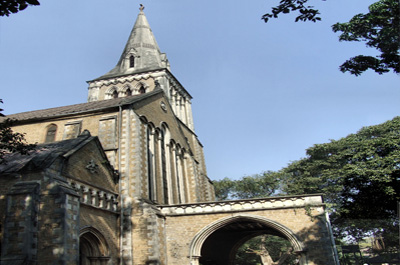Afghan Church Mumbai

In Colaba Island situated at the southern end of the city, church of St. John the Evangelist is located. Work on this church began in 1847 commemorating the Afghan wars. East India Company had used this place as a military cantonment area due to the remoteness of this place. At the southern tip of Mumbai, Afghan Church stands in a quiet army cantonment, an imposing basalt edifice with a lofty limestone spire that can be seen several miles away. In the old days it had a sizeable flock of British officers who turned up for the Sunday sermon. At the entrance, there is a big black board, revealing that it is an Anglican church dedicated to St. John the Evangelist. It is impressive with the wide Gothic Arches and beautiful stained-glass windows. It also commemorates different Indian regiments, including the Bombay Army, the Madras Army, and Ranjit Singh's army from Lahore.
The Directors of East Insdia Company converted a part of the Colaba Island into a military cantonment area, by selecting the remotest part of the Island with a view that the area should be isolated from the rest of the city so that there was not much interaction between the army men and the civilians in order to enforce military discipline. There was a compound located here with some buildings called 'Sick Bungalows' for the invalid officers who required sea air and sun bathing. Nearby was a small chapel with thatched roof allowing the soldiers to perform Sunday services. The conglomerate of 'Sick Bungalows', during those times, has now given place to a full-fledged hospital - 'INS Ashwini' - and the chapel gave way to the imposing church of St. Evangelist, commonly known as 'Afghan Church'. Few years later, the government provided the land for the building of the church on a condition that its steeple could be seen as a landmark at sea to guide ships navigating the Mumbai Harbour. Henry Coney Beare, the City Engineer, prepared the designs and construction began in 1847. Mr. Henry Coney Beare was the same person who laid down the great scheme for the construction of the Vihar Lake and distribution of water supply by iron pipes to nearly all parts of Mumbai City. These memorials take us back to the 'History of Afghan War'. Sind, which was the northwest gateway to the Indus valley, had always been a melting pot for many cultures that met and fused into the Indian culture forming a multi-coloured mosaic of the culture of modern India.
This was the first church of the famous Victorian architect, William Butterfield. Most of the important embellishments, such as the stained glass windows and the encaustic flooring are of the finest quality and were imported from England. The most exquisite portion of the church - Great West window, was designed by Wailles. It is the finest stained glass window to date in the city, superior to both the Rajabai Tower and the Victoria Terminus. The significance of the bell tower are the peals of eight bells that remain unrivalled in western India.
Opening hours: Daily dawn-dusk; the verger who lives next to the church will open the door if it is locked.
Admission: Free; donations welcome.







